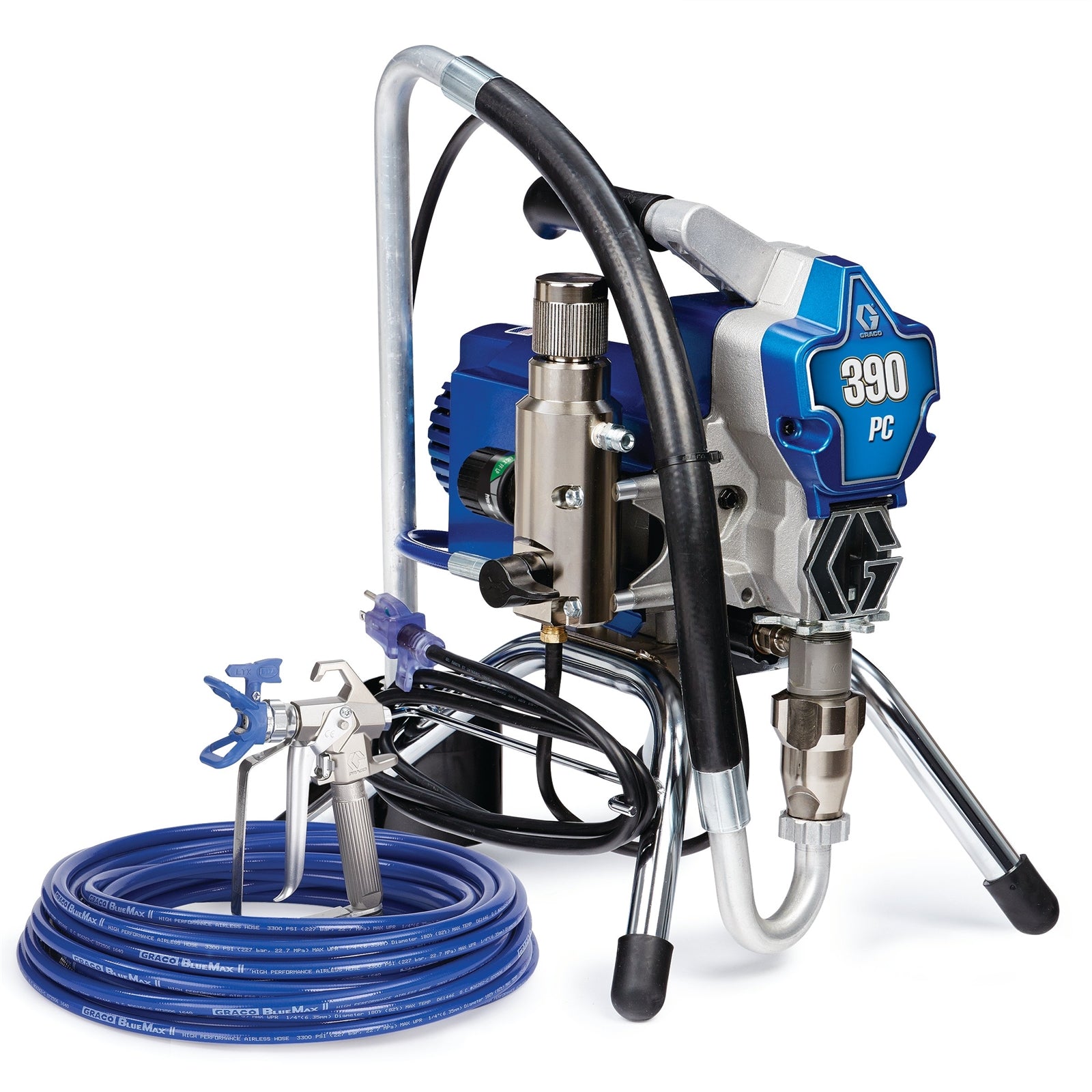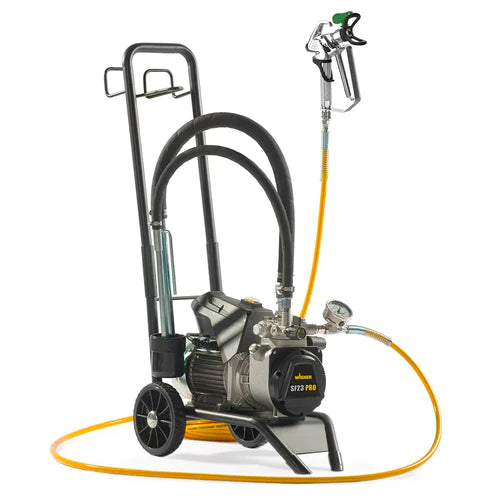Since the mid-1990s, the variety of airless paint sprayers available has expanded significantly with the world's leading brands developing new and innovative products. Airless sprayers are now among the most popular choices with professional and DIY painters alike . But most prospective airless paint sprayer purchasers still have questions, especially when it comes to the core components of a paint sprayer unit. Materials are an important consideration, as are things like warranties, guarantees, after-sales service. But a more fundamental question is, should you buy a paint sprayer with a piston pump or a paint sprayer with a diaphragm pump? In this short blog post we'll try to provide some information about each option and help you to make a decision about which is best for your next paint job.
Piston or diaphragm pump; what's the difference?
There are a few key differences between piston pumps and diaphragm pumps. Though both are airless pumps
Piston pumps are generally high-pressure pumps that produce better paint atomisation and are more suited to a wider range of materials. That means you can spray both high and low viscosity liquids. Piston pumps run only as needed, which means less wear and tear, and they are generally easier to repair. A stainless steel piston pump can last for years with careful and consistent maintenance.If pump life is an important consideration for you, a piston pump might be the right choice for you.
Diaphragm pumps move a larger volume of liquid while generally being smaller units, which means they are easier to move. They also offer better pressure control and work at a lower overall pressure. That makes them more efficient and cost effective. However, diaphragm pumps run constantly, which can mean more wear and tear over time. If efficiency and volume are important to you, a diaphragm pump might be the way to go.
Piston pump advantages

Piston pumps play a crucial role in paint sprayers, offering a wide array of advantages that significantly contribute to the efficiency and quality of painting projects. These powerful pumps provide a reliable and consistent performance, ensuring a steady paint flow and consistent spray patterns throughout the entire painting process.
One of the primary benefits of piston pumps is their ability to generate high pressure, which facilitates effective atomization of paint particles. This high-pressure output enables painters to achieve a smooth and even coat, resulting in a flawless finish. Moreover, piston pumps are remarkably versatile and can handle a wide range of paint viscosities, making them suitable for various types of paints and coatings.
When using piston pumps in paint sprayers, painters have precise control over the paint flow rate, allowing them to achieve accurate coverage and avoid overspray. The consistent pressure maintained by piston pumps further contributes to the uniform delivery of paint, ensuring an even application and eliminating any streaks or uneven patches.
Durability is another significant advantage of piston pumps. These pumps are constructed with robust materials and components, making them capable of withstanding frequent use and providing reliable performance over an extended period. Additionally, piston pumps are relatively easy to maintain, with accessible parts and straightforward cleaning procedures, ensuring optimal performance over time.
Paint sprayers equipped with piston pumps offer cost-effective solutions as well. By minimising paint wastage and reducing the need for rework, these pumps contribute to cost savings in the long run. Moreover, piston pumps facilitate efficient transfer of paint from the container to the sprayer, minimising downtime and maximising productivity during painting projects.
In terms of usability, piston pumps make painting operations seamless and time-saving. They provide painters with adjustable pressure settings, allowing them to adapt to different surface types and specific painting requirements. The fine mist created by piston pumps ensures uniform coverage and enhances the overall aesthetic appeal of the painted surface.
Piston pumps also reduce the likelihood of clogging compared to other pump types, ensuring uninterrupted paint flow and minimising downtime for maintenance. Many paint sprayers equipped with piston pumps are designed to be portable and lightweight, enhancing manoeuvrability and accessibility in different work areas.
In conclusion, the advantages of using piston pumps in paint sprayers are vast. From reliable performance and high-pressure output to precise control and efficient transfer of paint, these pumps offer a host of benefits that contribute to the success of painting projects. Their durability, cost-effectiveness, and ergonomic design further make them an indispensable tool for painters across various industries.
Diaphragm pump advantages

One of the primary advantages of diaphragm pumps is their ability to handle a wide range of paint viscosities. Whether working with thin or thick paints, diaphragm pumps can effectively transfer and atomize the paint particles, ensuring smooth and consistent spray patterns.
Diaphragm pumps are known for their exceptional versatility. They can accommodate various types of paint formulations, including latex, acrylic, enamel, and oil-based paints. This versatility allows painters to work with different paint materials and achieve desired results across a range of applications.
Another significant advantage of diaphragm pumps is their self-priming capability. These pumps can draw paint from a container and create the necessary pressure for atomization without requiring additional priming or external power sources. This feature saves time and simplifies the setup process, enhancing overall workflow efficiency.
Paint sprayers equipped with diaphragm pumps provide precise control over the paint flow rate. Painters can easily adjust the pump's pressure settings to achieve accurate coverage and maintain control over the paint output. This level of control ensures uniform application and minimises overspray, resulting in efficient paint usage and reduced wastage.
The diaphragm mechanism in these pumps also contributes to their durability and low-maintenance nature. Diaphragm pumps are designed to withstand the demands of paint spraying, with robust construction and fewer moving parts compared to other pump types. This design reduces the likelihood of breakdowns and simplifies maintenance, ensuring long-lasting performance.
Diaphragm pumps are renowned for their resistance to clogging. The diaphragm acts as a barrier between the paint and the pump mechanism, preventing debris or particles from reaching critical components. This feature reduces the risk of clogging, ensuring uninterrupted paint flow and minimising downtime during painting projects.
Additionally, diaphragm pumps are often lightweight and portable, enhancing mobility and ease of use. Painters can move freely around the worksite, reaching different areas without restrictions. This portability, combined with the pumps' efficient paint transfer and precise control, results in increased productivity and faster project completion.
In summary, diaphragm pumps offer numerous advantages for paint sprayers. Their ability to handle various paint viscosities, self-priming capability, precise control, and resistance to clogging make them an ideal choice for painters. With their durability, low maintenance requirements, and portability, diaphragm pumps are essential tools that contribute to efficient, high-quality painting projects across a wide range of applications.
Piston pump and diaphragm pump airless paint sprayer options
We recently published a blog post to help people choose the right paint sprayer with information about different air compressor paint sprayers, spray guns, and airless, pneumatic paint sprayers, and HVLP paint sprayer types.
PaintAccess stocks all types of paint sprayers, and among the best on offer are the following:
- The Graco Ultra cordless range is a great example of a compact piston pump airless paint sprayer from Graco. Ultra airless handheld paint sprayers are designed specifically for small interior, exterior and specialty projects.
- The Wagner SF23 Pro is a great diaphragm pump airless paint sprayer designed for professional contractors. It's built for construction site use including thicker coatings and larger projects.
- The Graco X5 airless paint sprayer is an outstanding piston pump unit, designed for thinner paints and medium-weight coatings from stains to latex paint. It's a great choice for handyman service providers and DIY home renovators.
Accessories for your airless paint sprayer
Airless paint sprayers are great for producing a consistently smooth finish for your painting project. But whether you choose a piston pump sprayer or a diaphragm pump sprayer, to get the best results you'll need the right accessories.
- Airless spray tips - depending on the type of paint you are applying, you'll need different sprayer tips. For thicker paints and heavier coatings, you'll need to change your spray tip size to ensure a more effective flow.
- Paint reservoir - gravity-fed paint sprayers use a paint cup or reservoir to feed a paint sprayer gun and are a popular option for handheld models. Most hold a quart of paint (American measurement) or a metric litre of paint.
- Stands - larger paint sprayers can benefit from a static or rolling stand which makes moving the paint sprayer and storing sprayer equipment convenient, and is almost essential for larger sprayers. A rolling stand makes it easier to get to hard-to-reach areas.
- Hoses - the length of your intake and sprayer hoses determines what you can get access to. Your max hose length is essentially the extent of your sprayer unit's range.
- Safety equipment - ensuring you are safe while applying paint with an airless sprayer is critical, and that means having the right gear. Safety goggles, gloves, closed shoes, and respirators (for roof coatings and textured architectural coatings) are all essential.
Before you start your spraying project, make sure you have all the equipment and accessories you need to be efficient and maintain safety.
Conclusion
Now that we have explored the benefits of different airless paint sprayer pump types, you can apply this new knowledge to selecting the right paint sprayer for the work you do and the projects you have planned. It's important to consider the types of coatings you plan to apply, the spraying finish you want to achieve, and the surface coverage you need.
PaintAccess can help you find your perfect choice of airless paint sprayer. Drop by either of our Sydney stores at St Leonards or Matraville, or order online and we'll ship it to you anywhere in Australia.
